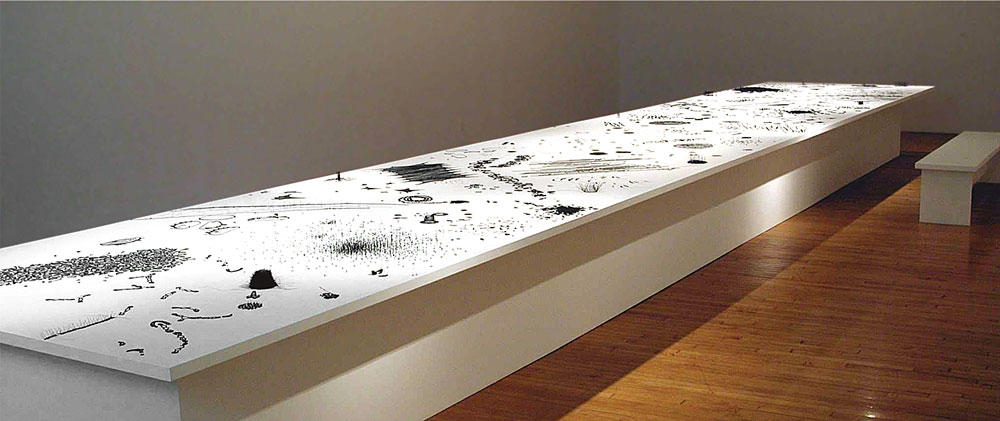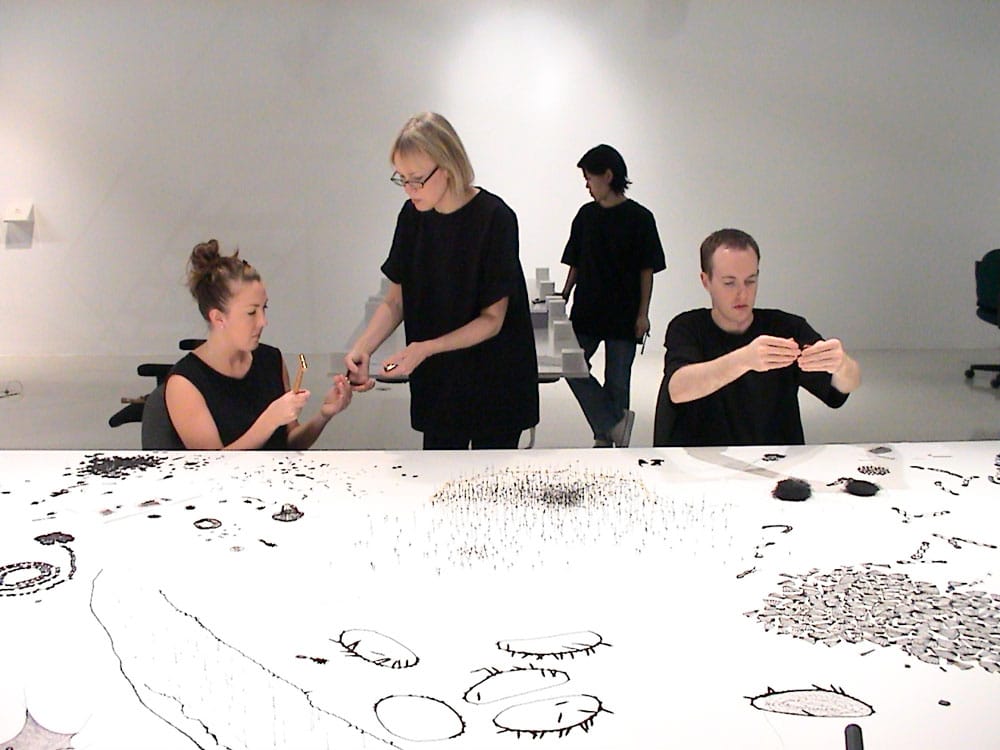 Anne Wilson, Topologies, 2002 – 2008
Anne Wilson, Topologies, 2002 – 2008
Lace, thread, cloth, pins, painted wood support
Dimensions variable
project statement
While our society faces a growing fragmentation and specialization that seems at times to alienate us all, we have also started to view our world as a series of integrated, even entangled networks. One way we can begin to understand this contradictory state is as a matrix of field phenomena – repetitive patterns of texture, growth, turbulence, sound, light, etc., within a given system or space.
– Douglas Garofalo, architect
Textiles, in their expandable and accumulative structure, can be seen as metaphors for such a matrix. In this new project, the webs and networks of found black lace are deconstructed to create large horizontal topographies, ‘physical drawings’ that are both complicated and delicate. This work is a constantly unfolding process of close observation, dissection, and recreation. The structural characteristics of lace are understood by unraveling threads; following the impetus to remake, mesh structures are also reconstructed through crochet and netting. The computer affords another means of close observation: lace fragments are scanned, filtered, and printed out as paper images. These computer-mediated digital prints are then re-materialized by hand stitching and are placed in relationship to the found and re-made lace in the topography.
The logic of organization within the project is based on the concept of like kinds. Never exactly repeating, areas of proximity are formed on the basis of the structural and visual characteristics of likeness. There is both unity and formlessness as parts coalesce, separate, and collide.
As a physical material, black lace has diverse cultural implications in relation to sexuality, death, and gender. These aspects of material context are embedded in the work, yet are not the dominant voice. This project references many things simultaneously: relationships between systems of materiality (textile networks) and systems of immateriality (Internet and the web); microscopic, specimen-like images of biology and the internal body; and macro views of urban sprawl – systems of organization of city structures, interdependent and/or parasitic, processes of expansion. No single theme or position is privileged over another.
This project is large in scale, but the specific configuration of installation is flexible, the size determined by the space at each venue as the project travels. The horizontal architectural support is created on site — a white painted wood platform.
exhibition history
Topologies (3-5.02), 2002
Installation, “2002 Biennial Exhibition,” Whitney Museum of American Art, New York
March 7 – May 26, 2002
Lace, thread, cloth, pins, painted wood support, 31 inches high x 74 inches wide x 18 feet long (overall dimension)
Topologies (9-12.02), 2002
Installation, “Anne Wilson: Unfoldings,” Sandra and David Bakalar Gallery, MassArt, Boston
September 4 – December 7, 2002
Lace, thread, cloth, pins, painted wood support, 31 inches high x 74 inches wide x 36 feet long (overall dimension)
Topologies (4-5.03), 2003
Installation, “Anne Wilson: Unfoldings,” University Art Gallery, San Diego State University
April 7 – May 7, 2003
Lace, thread, cloth, pins, painted wood support, 31 inches high x 74 inches wide x 36 feet long (overall dimension)
Topologies (1-4.04), 2004
Installation, “Perspectives 140: Anne Wilson,” Contemporary Arts Museum Houston
January 16 – April 4, 2004
Lace, thread, cloth, pins, painted wood support, 31 inches high x 74 inches wide x 36 feet long (overall dimension)
Topologies (11.07-2.08), 2007-08
Installation, “Out of the Ordinary,” Victoria and Albert Museum, London
November 13, 2007 – February 17, 2008
Lace, thread, cloth, pins, painted wood support, 31 inches high x 74 inches wide x 20 feet long (overall dimension)
